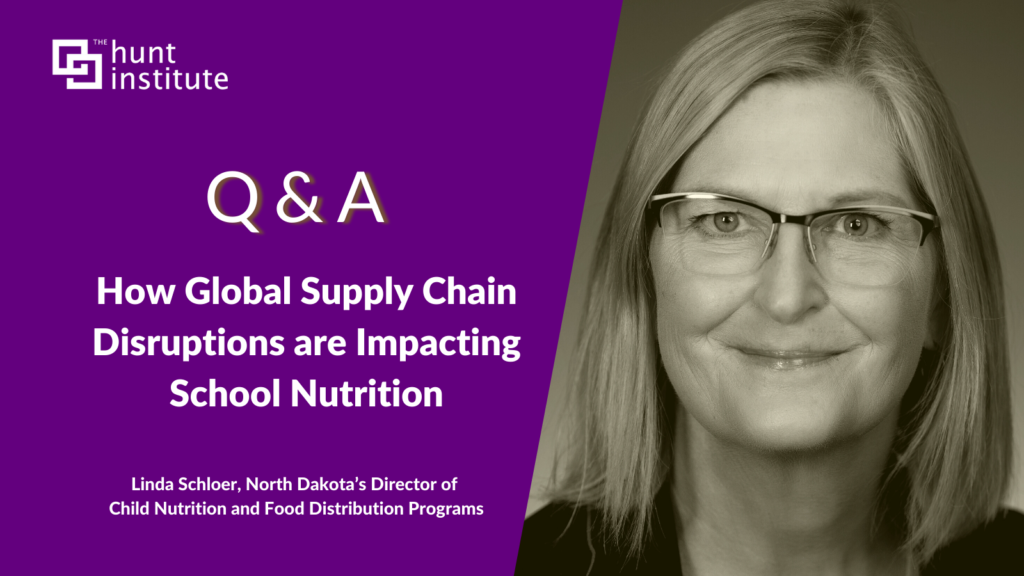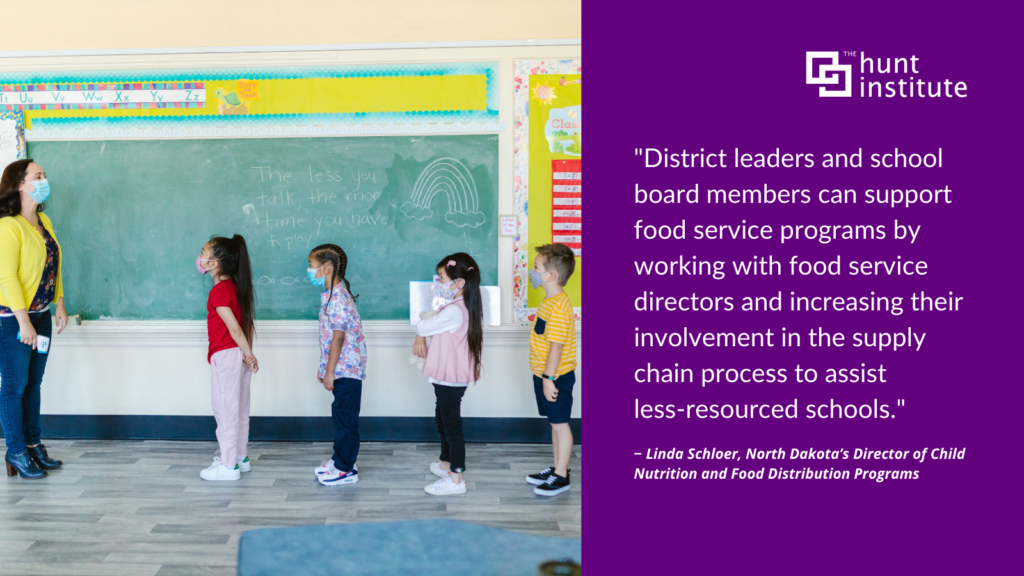How Global Supply Chain Disruptions are Impacting School Nutrition | A Q&A with Linda Schloer, North Dakota’s Director of Child Nutrition and Food Distribution Programs
February 7, 2022
 As economic activity continues to pick up, global supply chain issues over the past year have led to acute disruptions across the public and private sectors, including in schools. Despite the influx of federal relief funding for schools to deal with student nutrition, distribution delays and labor shortages have increased costs and limited the number of products and supplies reaching schools, especially in rural and high-poverty communities. These shortages have led some schools to deal with unexpected stock and other schools to resort to fast-food deliveries to feed their students. This is particularly concerning as studies show that schools provide the best opportunity for good nutrition for students. Unfortunately, the problems concerning food distribution exist at nearly every step of the supply chain puzzle, including product shortages, distributer cancellations, delayed and canceled deliveries, staffing shortages, and inflation, leaving 97 percent of school nutrition directors concerned about continued pandemic supply chain disruptions, according to the School Nutrition Association’s Back to School 2021 Survey.
As economic activity continues to pick up, global supply chain issues over the past year have led to acute disruptions across the public and private sectors, including in schools. Despite the influx of federal relief funding for schools to deal with student nutrition, distribution delays and labor shortages have increased costs and limited the number of products and supplies reaching schools, especially in rural and high-poverty communities. These shortages have led some schools to deal with unexpected stock and other schools to resort to fast-food deliveries to feed their students. This is particularly concerning as studies show that schools provide the best opportunity for good nutrition for students. Unfortunately, the problems concerning food distribution exist at nearly every step of the supply chain puzzle, including product shortages, distributer cancellations, delayed and canceled deliveries, staffing shortages, and inflation, leaving 97 percent of school nutrition directors concerned about continued pandemic supply chain disruptions, according to the School Nutrition Association’s Back to School 2021 Survey.
While some are confident that market systems will eventually recover, those systems may be slow to get back on track, especially as the pandemic continues to impact the economy. As the school year continues, district and school leaders experiencing these challenges must consider alternative strategies to continue providing nutritious food options to students who need it. In North Dakota, for example, some schools have turned to local procurement from grocery stores and a local co-op is considering using underutilized postal trucks to deliver food to schools as temporary measures.
To gain more insight on how supply chain disruptions are impacting schools and what they are doing to address these challenges, The Hunt Institute spoke with Linda Schloer, North Dakota’s Director of Child Nutrition and Food Distribution Programs.
As we’ve all experienced in one way or another, global supply chain problems have been intensely felt at the local level, regardless of industry. How are these disruptions impacting school nutrition in North Dakota?
Late last year, food distributors had to terminate contracts, largely due to staffing shortages resulting in fewer truckers to deliver food and supplies. Half of the state’s school districts participate in the North Dakota Educators Services Cooperative, a joint organization of school districts, cities, counties, and other governmental groups that work together to negotiate savings on goods and services. In October 2021, a major food distributor ended its contract with the Cooperative due to worker shortages, impacting around 100 school districts in the state. In response, some districts have had to scramble to find their own distributors at higher costs, while others are still struggling to find a consistent food supply stream, opting for procurement of local goods in the short term.
Moreover, some districts are in more rural areas, making it more difficult for trucks to reach those districts. For example, Alexander Public Schools, located in the northwest part of the state, is working with a distributor based in Montana. Workers from Enderlin Public Schools in southeast North Dakota must travel 52 miles one way to pick up their groceries from their distributor. On the other hand, the parts of the state that are generally more urban and suburban have access to a greater variety of resources and are not facing as many issues concerning food distributors.
Some say that recovering from this issue will be a slow and gradual process. What have schools in your district or other districts in the state been doing to address the school lunch shortage in the interim, and have these efforts been effective? What partners have you been able to rely on to help solve these issues in your community?
Districts have accepted that these disruptions may continue for a while and therefore have had to adapt to the effects of these disruptions, including higher food costs, staffing shortages, and variable food supplies. Since there is no guarantee that what is on the menu will be available that day, schools have had to learn to be more flexible and creative with the ingredients they have on hand, such as reimagining one ingredient into multiple dishes. Districts have also changed the way they work with their vendors, including engaging in more frequent communication. Despite these efforts, many schools have still had to cut down on the number of food options offered to students due to limited supply.
Fortunately, the United States Department of Agriculture (USDA) meal waivers have been helpful. Normally, school meals must contain certain types of food and nutrients in specific quantities to provide students with a balanced diet. While that is always our goal, the waivers have provided schools some flexibility with that requirement. Pockets of funding from the USDA have been helpful and has allowed schools to serve all students free lunch this school year, regardless of free or reduced-price lunch status. Last year, we also paid out our Emergency Operating Funds, which compensated schools for revenue lost in 2020. The USDA also announced in December that $1 billion in Supply Chain Assistance Funds will go out to states soon, and we will receive $2.8 million to allocate to North Dakota school districts in March. The districts impacted the most from contract terminations are seeing the greatest price hikes, so these federal funds will help.
Partnerships between districts and the private sector have also been key in keeping things moving. As I mentioned before, districts are focusing more on purchasing through local businesses and grocery stores. For example, Lone Tree Public Schools has been picking up its food from local grocery stores, while other school districts have partnered with local businesses to purchase beef. In one small district, community partners assisted in picking up and delivering food orders, and in others, partners helped districts identify alternative foodservice distributors that have not traditionally served schools, such as those supplying restaurants. Overall, we are seeing greater partnership efforts within communities to ensure that student nutritional needs are met, which has been a positive outcome.

What can state and district leaders do to continue supporting schools to ensure that all students are properly fed?
District leaders and school board members can support food service programs by working with food service directors and increasing their involvement in the supply chain process to assist less-resourced schools. Small schools and districts could also partner together and leverage their combined strengths to purchase food in greater volumes at a lower cost. Furthermore, developing a network of community members and businesses who can help during times of emergency is critical to ensuring that food continues to be delivered to districts.
Schools can also improve their communication and transparency with students and families about their circumstances, explaining that due to supply chain issues, the variety of options in school lunches can no longer be guaranteed. Initially, parents expressed frustration about the food shortages, but over the course of the year, they became more understanding.
Most importantly, school and district leaders must think about the future, as there may continue to be uncertainty about the pandemic, federal funding, and supply chain issues. Though schools were able to offer free meals to all students this year, the USDA has not indicated what kinds of reimbursements they will offer in the upcoming school year. We are also concerned about recruiting and retaining food service directors who have sufficient knowledge of school nutrition management and operations. This year, Idaho has seen significant attrition in this position, and we are worried that North Dakota will face the same issue. These factors have led to a lot of anxiety among administration and staff at a time when school districts have little control over their environments.


